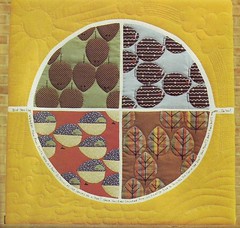I've mentioned Charles Harper a few times before, mainly in reference to the fused bird pictures The Mother made for me several birthdays ago. The geometric, draftsmen-like quality of Harper's animal illustrations have always struck me as readily translatable into a quilt, so I tittered with delight when I saw this quilt in a 1978 issue of Lady's Circle Patchwork Quilts. Here's the caption from the magazine:
Lenore Parham borrowed from a design by Charles Harper in Ranger Rick (The National Wildlife Federation children's magazine) to create this charming wall hanging.I was at a secondhand book shop, and this picture alone moved the magazine from the "maybe" to the "definitely must have" stack. I had figured it was just a photo to go with an article on the Blue Ridge Quilters, and it wasn't till I got home that I saw they'd patterned the quilt too! So I may just have to sew up my own version. The design is especially fun since the quadrants of the circle use the same basic shape to depict three different animal as well as trees, and the quilting is quite fun too.
My first thought, though, was that something like this could never get published today (he said, pulling out the soapbox and climbing up onto it). Such "borrowing" would never get past the copyright police; a current magazine wouldn't take the chance that some lawyer somewhere might consider the quilt an infringement. I certainly understand the need for artists to protect their work, but the stifling that happens as a result of today's voracious protection of derivative works is sad. And what's the result? Other artists can't make money off the first artist's work, but lawyers and licensing agents can make a tidy sum. An original designer (or their estate, as the case would be for Harper) may or may not be willing to allow derivative quilts or other works that don't compete with the original, but the process of seeking permission is enough to kill the creative impetus. Copyrights and Copywrongs and Free Culture (available online) make the point in more detail, if you're interested. And take a look at Wendy Seltzer's article "Craft and Copyright" in volume 6 of Craft magazine for the most balanced, reasoned, sensible advice on copyright I've seen—a far cry from the many scaremongering articles that combat quilters' and crafters' myths about copyright with more myths. OK, now I can put the soapbox away.


4 comments:
You said "I had figured it was just a photo to go with an article on the Blue Ridge Quilters, and it wasn't till I got home that I saw they'd patterned the quilt too!" and I wondered if that pattern would be something you might share. Have you seen some of the Todd Oldham Charley Harper influenced textiles? They appear to be beautiful, but purposed for upholstery rather than quilting.
I'm so glad to have discovered your blog, and have really enjoyed reading it - my first ever blogging experience! I don't know that I have a Google/Blogger identity, or what an OpenID or Name/URL requires of me, so I will, this one time, remain anonymous in Davidson, North Carolina. I'll check your blog later. Thank you for sharing the photo of the Harper quilt, as well as the fabricphotos the Mother created for you. Delightful. Inspiring, actually.
I know this is an old post, but I just stumbled upon this blog and thought I would share. There's a quilter's club in Cincinnati (Charley Harper's- and my- hometown) that is dedicated to only making quilts based on CH's artwork. Might be worth further investigation if you're interested.
I was trying to take a look at your "Birds of a Feather" or "Bird Crossing" pattern. When I clicked on the link on this page, it is a broken link. I saw a picture of the quilt on Pinterest which brought me to your site.
I'm not sure where the broken link is, but the Bird Crossing pattern is available on my website at http://www.feeddog.net/shop/quilt-patterns/bird-crossing-quilt.html. Thanks!
Post a Comment